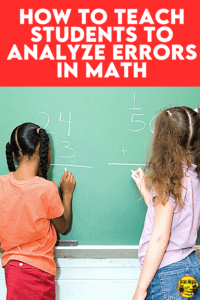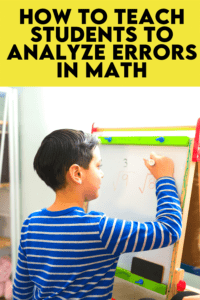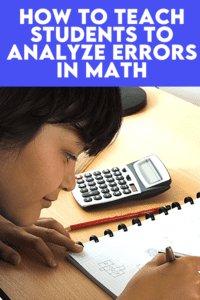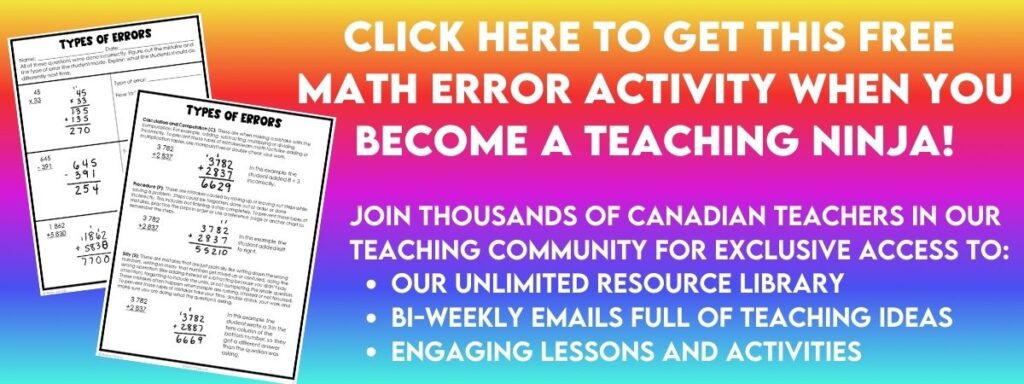
Over the years, we’ve had students that don’t want to correct their math errors. Why do students need to know how they made a mistake? For students, it helps them understand where they went wrong so they don’t repeat the errors. For teachers, it helps narrow down how to support or teach the student. But how do you teach students to analyze errors in math?
Why Do We Teach Students to Analyze Errors?
We’ve broken it down into the three types of errors that we see from our students. During math class, we explicitly teach the different types of mistakes that we see as teachers. When students learn to identify mistakes, it helps deepen their understanding of concepts. They can begin to correct their own errors and they develop confidence.
What Are the Three Types of Errors?
Procedural Error
These are mistakes that are made during the process. This might be missing a step. It could be doing the steps out of order. Maybe the students couldn’t remember all of the steps.
To help students with procedures, we write out the steps or make visual steps for each concept. These can be stored as anchor charts, but in our classroom, we include these in our Interactive Math Units. There is more information about our units later in this post.
Calculation or Computation Error

These are mistakes made when adding, subtracting, multiplying or dividing. Students who struggle with their math facts will find these errors are the most common for them. Sometimes, these errors come from a lack of practice, a lack of number sense, or students who work too quickly and don’t go back to check their work.
To help students who make these types of errors, we try to provide opportunities to practice. We practice math facts in our classroom regularly and graph our progress. This progress is kept in their math books and is private information between the teacher and the student.
To practice, we use these materials:
(5 x 5 = 25) Multiplication & Division Find this set in our TpT Store ($USD) or BN Shop ($CAN).
(7 x 7 = 49) Multiplication & Division Find this set in our TpT Store ($USD) or BN Shop ($CAN).
(9 x 9 = 81) Multiplication & Division Find this set in our TpT Store ($USD) or BN Shop ($CAN).
(10 x 10 = 100) Multiplication & Division Find this set in our TpT Store ($USD) or BN Shop ($CAN).
(12 x 12) Multiplication & Division Find this set in our TpT Store ($USD) or BN Shop ($CAN).
The bundle with all five sets can be found in our TpT Store ($USD) or BN Shop ($CAN).
Our students use concrete models whenever possible until they know their facts well. We paste multiplication charts into their math journals and show students how to use these charts for multiplication and division. In our classroom, students are encouraged to use manipulatives so they can see computation in concrete ways. Fraction blocks, Base 10 blocks, Unifix Cubes, clocks, pattern blocks and place value charts are just some of the materials available to our students any time they need them.
Silly Error
These errors are often made when students rush or are unfocused. They might copy down a question incorrectly by mixing up numbers or even writing down the wrong ones. Sometimes, the error comes from writing numbers that get mixed up because they are too messy to read. This might be a zero that looks like a six or a four that resembles a nine.
Other silly errors can happen because students don’t follow the directions. They might answer the wrong question or miss a question completely. These aren’t really math errors because students have not necessarily done the math incorrectly, but we try to teach our students that following these directions is important in later grades when assessments become more intense.
Sometimes, students don’t do what the question is asking. We see this all the time in poorly designed worksheets. There might be three rows of addition, and then one row of subtraction and it’s not clearly marked, so students just do every question as addition. Other times, they don’t quite do everything the question intended. When we start doing multistep word problems, the first weeks are spent reminding students to go back and check that the second step is done.
We help students with silly errors by showing them how to properly check for errors. That is why teaching error analysis is important. Students can’t fix what they don’t know. Some students add a step in their procedures to double-check they’ve written down the question correctly or to check their answers when they finish.
Grab this error analysis activity that you can use in your math class to help students understand the errors that mathematicians make. You can get your free copy in the Resource Library or we can send you a copy when you join our email list.
Show Students How to Analyze Errors in Math Class

Using any worksheet for the concept you’re working on, complete the worksheet ahead of class time, but do all the questions incorrectly. Intentionally use the three different types of errors so that your class will be able to analyze where you’ve gone wrong.
You can explain the errors before doing the worksheet or use the worksheet to introduce the three types of errors.
Tell your students that you got an answer key for this worksheet, but none of the answers seem right. Ask them to fix the answers. They’ll go straight to getting the answers and that’s okay at first. Ask for the answer to the first question. Explain that you want to know how the question on the answer key is wrong. What did the person do wrong? Once your students find the mistake, name it as one of the three errors.
Keep doing this as you work through the corrections on the worksheet. Once you have two of each error, stop to teach the errors explicitly. If you’re looking for more ways to use a worksheet read Math Worksheet Games Your Students Will Love.
If you’re looking for worksheets, we’ve worked hard to make student-friendly worksheets. We have sets of worksheets. These are the big bundles, but we also have more targeted concept sets.
Grade 3 Worksheet Bundle. Find the bundles in our TpT Store ($USD) or our BN Shop ($CAN).
Grade 4 Worksheet Bundle. Find the bundles in our TpT Store ($USD) or our BN Shop ($CAN).
Grade 5 Worksheet Bundle. Find the bundles in our TpT Store ($USD) or our BN Shop ($CAN).
Grade 6 Worksheet Bundle. Find the bundles in our TpT Store ($USD) or our BN Shop ($CAN).
Create an Anchor Chart
Grab a piece of chart paper and put the three types of errors across the top. Explain the three errors and write down a few keywords that will help your students remember what they mean. Using an example or two from the worksheet, copy an example for each type of error onto the chart.
Return to the worksheet, and instead of having students give you the answers or corrections, ask them to figure out what type of error is happening in each question.
Next time your students complete work on their own, have them mark their own work and then analyze the errors. Explain that mistakes are normal, but if we know the types of mistakes we’re making, teachers can target those mistakes and help students much faster.
If your students use interactive notebooks, have them make a chart in their notebook so they can refer to it. They might even be able to identify the types of mistakes they tend to make.
When we hand back unit tests, we go through all the answers together as a class, but instead of corrections, students write in the type of errors made. We label them P for procedural, C for computation and S for silly. It’s important to point out to your students that all types of errors make math more difficult, but there’s not one type of error that is more common or more difficult to learn from. Different types of math questions create different types of errors. And different students make different errors.
The important thing is to learn from the errors.
How Do Interactive Math Notebooks Help to Analyze Errors in Math?

Interactive Math Notebooks are books we create with students. Each set of pages outlines a concept so students can refer to the pages while they practice the skill. We include vocabulary, diagrams and examples and create the pages with our students so they learn and build the books.
While this is an investment in time, we have found that using notebooks increases our students’ ability to gain independence when working through challenges. They learn to use these books to help get them during class when we’re not available to spend time with them.
Our math notebooks come with complete lesson plans. These plans include each step needed to set up the notebook as part of the lesson with your students. Practice pages, games and activities are part of the sets so that your students can practice each concept as they learn. We’ve even included assessments so you can check for student understanding.
We have aligned these notebooks to Alberta, BC and Saskatchewan Math outcomes, but they work for most Canadian classrooms.
Interactive Math Units for Grade 3
Representing Numbers and Fractions on TpT ($USD) or our BN Shop ($CAN).
Number Operations on TpT ($USD) or our BN Shop ($CAN).
Patterns and Algebra on TpT ($USD) or our BN Shop ($CAN).
Statistics and Graphing on TpT ($USD) or our BN Shop ($CAN).
Time and Measurement on TpT ($USD) or our BN Shop ($CAN).
Geometry on TpT ($USD) or our BN Shop ($CAN).
Full Year Bundle on TpT ($USD) or our BN Shop ($CAN).
Interactive Math Units for Grade 4
Representing Numbers on TpT ($USD) or our BN Shop ($CAN).
Number Operations on TpT ($USD) or our BN Shop ($CAN).
Decimals and Fractions on TpT ($USD) or our BN Shop ($CAN).
Patterns and Algebra on TpT ($USD) or our BN Shop ($CAN).
Statistics and Probability on TpT ($USD) or our BN Shop ($CAN).
Reading Clocks and Elapsed Time on TpT ($USD) or our BN Shop ($CAN).
Measurement on TpT ($USD) or our BN Shop ($CAN).
Geometry on TpT ($USD) or our BN Shop ($CAN).
Full Year Bundle on TpT ($USD) or our BN Shop ($CAN).
Interactive Math Units for Grades 4/5
Representing Numbers on TpT ($USD) or our BN Shop ($CAN).
Number Operations on TpT ($USD) or our BN Shop ($CAN).
Decimals and Fractions on TpT ($USD) or our BN Shop ($CAN).
Statistics and Probability on TpT ($USD) or our BN Shop ($CAN).
Patterns and Algebra on TpT ($USD) or our BN Shop ($CAN).
Reading Clocks and Elapsed Time on TpT ($USD) or our BN Shop ($CAN).
Measurement on TpT ($USD) or our BN Shop ($CAN).
Geometry on TpT ($USD) or our BN Shop ($CAN).
Full Year Bundle on TpT ($USD) or our BN Shop ($CAN).
Interactive Math Units for Grade 5
Representing Numbers on TpT ($USD) or our BN Shop ($CAN).
Number Operations on TpT ($USD) or our BN Shop ($CAN).
Decimals, Fractions, Ratios and Percents on TpT ($USD) or our BN Shop ($CAN).
Patterns and Algebra on TpT ($USD) or our BN Shop ($CAN).
Statistics and Probability on TpT ($USD) or our BN Shop ($CAN).
Calculating Elapsed Time on TpT ($USD) or our BN Shop ($CAN).
Measurement on TpT ($USD) or our BN Shop ($CAN).
Geometry on TpT ($USD) or our BN Shop ($CAN).
Full Year Bundle on TpT ($USD) or our BN Shop ($CAN).
Interactive Math Units for Grades 5/6
Representing Numbers and Integers on TpT ($USD) or our BN Shop ($CAN).
Whole Number Operations on TpT ($USD) or our BN Shop ($CAN).
Decimals, Fractions, Ratios and Percent on TpT ($USD) or our BN Shop ($CAN).
Statistics and Probability on TpT ($USD) or our BN Shop ($CAN).
Patterns and Algebra on TpT ($USD) or our BN Shop ($CAN).
Measurement on TpT ($USD) or our BN Shop ($CAN).
Geometry (includes the first quadrant of the Cartesian Plane) on TpT ($USD) or our BN Shop ($CAN).
Full Year Bundle on TpT ($USD) or our BN Shop ($CAN).
Interactive Math Units for Grade 6
Representing Numbers and Integers on TpT ($USD) or our BN Shop ($CAN).
Number Operations on TpT ($USD) or our BN Shop ($CAN).
Decimals and Fractions on TpT ($USD) or our BN Shop ($CAN).
Patterns and Algebra on TpT ($USD) or our BN Shop ($CAN).
Statistics and Probability on TpT ($USD) or our BN Shop ($CAN).
Measurement on TpT ($USD) or our BN Shop ($CAN).
Geometry on TpT ($USD) or our BN Shop ($CAN).
Full Year Bundle on TpT ($USD) or our BN Shop ($CAN).
How Does Learning to Analyze Errors in Math Help During Assessments?

Understanding math errors is important for a few reasons.
As a teacher, seeing where a student is making mistakes and looking for patterns can help you plan interventions sooner. The more you know about your students, the better you can target specific skills or be proactive when choosing lessons and activities to support their learning. Instead of saying to check your work when they have finished a task, ask them to check for errors. This is more specific and changes the mindset.
As a student, understanding why you’re making mistakes, it becomes easier to use specific tools to help. Some students don’t want to be seen using manipulatives, but sometimes, these interventions are only needed temporarily until the learning sticks.
Generally, learning about errors comes in handy as math gets more complex as students move up through the grade levels. Students can look at assessed work and can ask for more specific help other than, “I don’t get it.” It is empowering for students to be able to say something more specific, like, “I can’t remember what to do after the second step.”
Need More Math Ideas?
If you’re looking for math lesson ideas, be sure to check out some of our other posts.
- Use Interactive Math Notebooks to Teach Number Sense
- How to Change Math With Interactive Notebooks
- Conquer Math With These Multiplication Strategies
- How to Add Candy to Your Math Lessons
- Ways to Teach Shape and Space
- How to Help Your Students Master Decimal Operations
- Ways to Bring Graphing Activities into Your Classroom Daily
- How to Teach Successful Long Division Strategies
- How to Make Teaching Patterns Painless
- Ways to Teach Classifying Triangles
- How to Teach Rounding Numbers
Need parents to buy into this method of teaching? Try reading The Truth About New Math.
Do you teach your students to analyze errors in math? What has worked for you?







